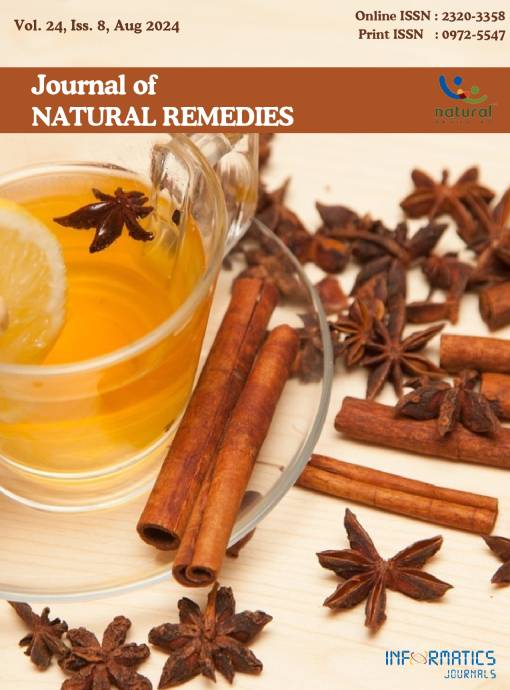Comparative Analytical Study of Shatavari Ghrut Prepared by Two Different Rules of Snehapak: A Quantitative Estimation of Shatavarin IV
DOI:
https://doi.org/10.18311/jnr/2024/42113Keywords:
Duration of Snehapak, Physicochemical Analysis, Sneha Kalpana, StabilityAbstract
Background: Sneha Kalpana is an important dosage form in Ayurveda known for treating various diseases. Sneha Kalpana involves extracting fat and transforming water-soluble active components from simple ingredients into a fatty substance known as Sneha. There are many rules mentioned for Sneha preparation, which include an essential guideline of adhering to a specific time duration for the Snehapaka process. This duration is not fixed and varies depending on the nature and constituents of the Dravya (ingredients) incorporated along with the Sneha. Aim: To prepare Shatavari Ghrut adhering to both the rules, develop SOP and then analyse its physicochemical properties, quantitative High-Performance Thin Layer Chromatography (HPTLC) analysis and microbial counts. Method: Shatavari Ghrut is one of the formulations which is broadly used in Ayurveda practice. In this formulation milk is used as liquid media and also the roots of Shatavari (Asparagus racemossus wild) are used. According to the time duration of snehapak, two rules are applicable here, which are, Sneha is prepared using milk for a duration of 2 days and Sneha is prepared using Mool (Roots) for 12 days, so accordingly Shatavari Ghrut 1 (SG1) is prepared in 2 days and Shatavari Ghrut 2 (SG2) is prepared in 12 days. Result: The physicochemical parameters suggest that both the SG1 (2 days) and SG2 (12 days) exhibit similar characteristics with minor variations, the HPTLC fingerprinting results for both the SG1 and SG2 samples observe that Shatavarin IV percentage is higher in SG2 (12 days) than SG1 (2 days). Conclusion: The higher concentration of Shatavarin IV in the SG2 (12 days) indicates that prolonged processing enhances the extraction or synthesis of this bioactive compound in Shatavari Ghrut. So SG2 may have better therapeutic efficacy and higher stability than SG1.
Downloads
Metrics
Published
How to Cite
License
Copyright (c) 2024 Ashvini Paradkar, Anita Wanjari (Author)

This work is licensed under a Creative Commons Attribution 4.0 International License.
Accepted 2024-07-01
Published 2024-08-31
References
Pandey K, Dr Chaturvedi G, Charak Samhita Sutrasthana. Edited by Rasjeshwar Shastri. Chaukhambha Bharti Akadami, Varanasi. 22(13):257.
Fulkar S, Aher A, Joshi MA. A study of Ghrita Kalpana with reference to Charak Samhita. International Ayurvedic Medical Journal. 2014; 2(5):780-7.
Shastri A, Bhaishajya Ratnavali, Jwara Chikitsa. Chaukhamba Prakashan. Varanasi. 1996; 16(5):189.
Paradkar A, Wanjari A. Development of standard operating procedures and pharmaceutical study of herbal lipid preparation. Ann. Phytomed 2023; 12(2):1005-11. https://doi.org/10.54085/ap.2023.12.2.120
Noorul H, Nesar A, Shaikh Z, Mohd K, Juber A. Asparagus racemosus: for medicinal uses and pharmacological actions. International Journal of Advanced Research. 2016; 4(3):259-67.
Pal S, Saokar R, Kadibagil V. A review on shatavari ghrita. Ayurpub. 2016; 1(2):59-63.
Yadav S, Dadhich O. A small group study on the evaluation of effects of Shatavari ghrita in management of vatarakta w.s.r. to gout. World Journal of Pharmaceutical Research. 2017; 6(12):703-9.
Patil R. Virechana paschat shatavari ghrita uttara vasti in ksheena shukra- a case study. International Journal of Informatics and Communication Technology. 2016; 4(9):29-31. https://doi.org/10.11591/ijict.v4i1.pp29-37
Bhokardankar P, Mane S, Khairanar B. An overview of shatavari (Asparagus racemosus) an Ayurvedic drug. International Journal of Ayurveda and Pharma Research. 2019; 7(7):60-8. https://doi.org/10.47070/ijapr.v7i7.1256
Dutta S, Sengupta P. Medicinal herbs in the management of male infertility. J Pregnancy Reprod. 2018; 2(1):1-6. https:// doi.org/10.15761/JPR.1000128
Siddhpura B, Parmar D, Umretia B. Validation of wet and dry drug collection principle in the preparation of shatavari ghrita through quantitative estimation of Shatavarin IV, research and reviews: A journal of drug formulation, development and production. 2021; 8(2).
Thakur K, Anchal N, Jaswal S, Bhatt A. Evaluation of antimicrobial potential of root extract of Asparagus racemosus Willd and bark extract of Juglans regia L. against pathogenic bacterial isolates. Ann Phytomed. 2018; 7(2):64-9. https://doi.org/10.21276/ap.2018.7.2.9
Pal S, Kadibagil V, Saokar R. The pharmaceutico analytical study of shatavari ghrita. Int J Ayu Pharm Chem. 2020; 12(1):201-12.

 Ashvini Paradkar
Ashvini Paradkar









 0.35
0.35 24
24 0.161
0.161